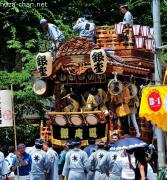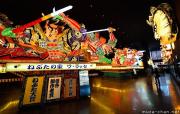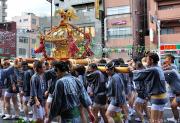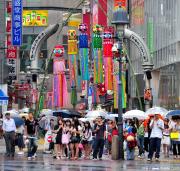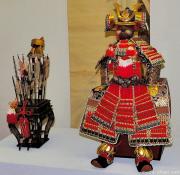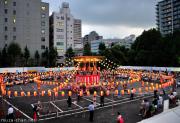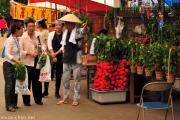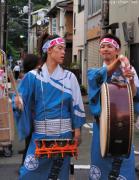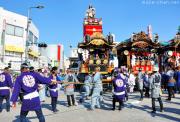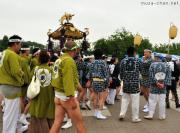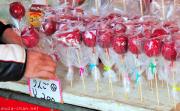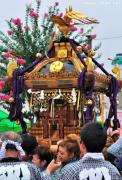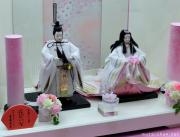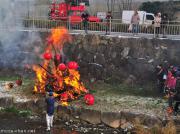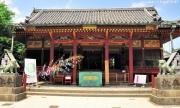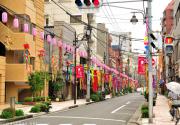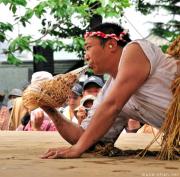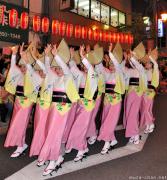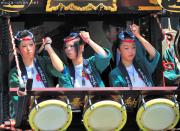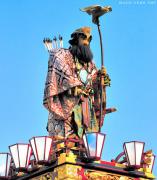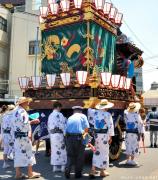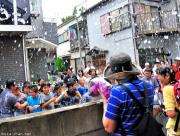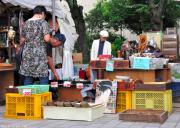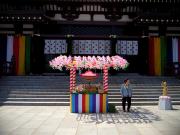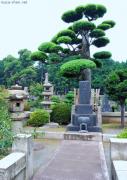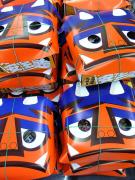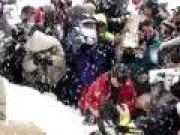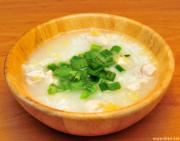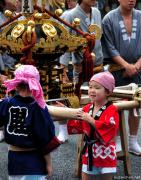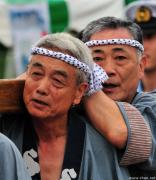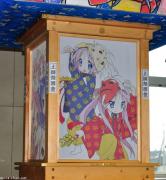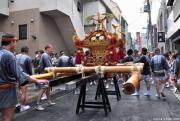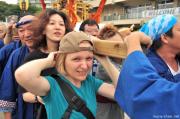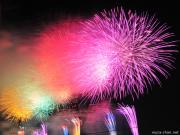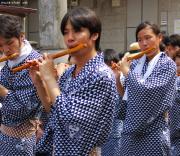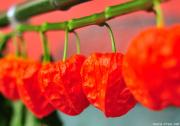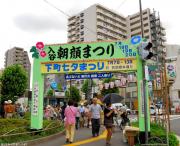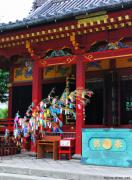12 years of travel throughout Japan
Discover Japan through the eyes of a seasoned traveler
Japanese festivals - matsuri
20 Nov 2019: Floats Parade at Uchiwa Matsuri
Uchiwa Matsuri, Atagoyasaka Shrine Kumagaya Saitama Photo date: July 2010 Photo location: Google Maps Floats Parade at Uchiwa Matsuri, Kumagaya, SaitamaNikon D90 Lens: 18-70mm F/3.5-4.5G Focal Length: 18mm Aperture: ... »
07 Oct 2014: Aomori Nebuta Matsuri spectacular floats
Aomori Nebuta Matsuri is one of the largest Japanese festivals, being counted as one the three greatest festivals taking place in the Tōhoku region. It takes place at the beginning of August and it is certainly a "must see", but if you visit Aomori during other period of time, you can still ... »
29 Aug 2013: Mizu-kake Matsuri
In the midst of the summer, on the streets of Fukagawa, Tokyo, nearby the Tomioka Hachimangu Shrine, you can witness Mizu-kake Matsuri, a festival renowned in all Japan, one of the three major Edo festivals, along with the Sanno Festival at Hie Jinja Akasaka Shrine and the Kanda Festival at Kanda ... »
15 Aug 2013: Dancing to stop the rain, Mizudome-no-Mai
The rainy season in the Kanto area, tsuyu ("plum rain"), takes place approximately between June 8 and July 20. Sometimes in the past the heavy rains led to flash flooding and one such flooding, 700 years ago, determined the apparition of a beautiful tradition which has been preserved until today. ... »
25 Jul 2013: Japanese Customs and Traditions, the Dance of Fools
In the fourth Saturday and Sunday of July, which this year is tomorrow and the day after tomorrow, for 2 hours after dusk, the streets around the Bishamonten Zenkoku-ji in Kagurazaka, Tokyo will be flooded by frenetic dancers... One of the most beautiful festivals taking place in Japan, the Awa ... »
11 Jul 2013: Japanese Customs and Traditions, Toro nagashi
Soon, in Japan will begin the Obon celebration, one of the oldest and most important Japanese festivals. Depending on the region, Obon takes place in the middle of July or August and it lasts for 3 or 4 days.According to the Japanese tradition, during the first day of Obon the souls of the ... »
07 Jul 2013: Fukinagashi streamers, Tanabata decorations in Shibuya
There are many customs and traditions related to Tanabata, the Japanese star festival celebrating the old story of Orihime and Hikoboshi. The most popular custom is to write your wishes on a tanzaku and to hang it on a bamboo branch. Another custom is to take a stroll on the streets decorated with ... »
05 May 2013: Boys Day, Tango no Sekku Samurai Armor
Similar to the Girls Day - Hina Matsuri, Japan also celebrates the Boys Day - Tango no Sekku, on May 5th. On this occasion, the families with boys are rising koinobori and are setting up inside the house a very beautiful display.This can be a Gogatsu Ningyo (dolls representing famous samurai or ... »
03 Mar 2013: Hina Matsuri Traditional Dolls
One of the most beautiful celebrations in Japan takes place today: Hina Matsuri - the Doll Festival, a day when the families with girls are displaying a very special set of dolls, hina-ningyō, thus praying for their girl's good health and happiness. As you can see from my photo, the ... »
10 Jan 2013: Eating roasted mochi at Dondo Yaki
In Japan, many religious events, especially the Shinto ones, are ending with a popular party, usually with some specific food. This is by no means a trivialization, everything simply becomes friendlier and more enjoyable... That's a part of Japan's charm!That's what happens at Dondo Yaki ... »
01 Jan 2013: First day of the year, Hatsumode
On the first day of the year, one of the main events in Japan is the first visit to the shrine or temple, Hatsumode. It can be done during the first days of the year, but many people prefer to do it immediately after midnight. That's why, a few hours before midnight, at the most famous temples or ... »
04 Dec 2012: Big drum, Odaiko
I love taiko and every time I go to a taiko concert I am fascinated by the sound of the odaiko, the big drum. With impressive sizes (sometimes these giant drums are over 2 meter diameter), an odaiko is often a true work of art: carved from a single tree trunk, the manufacturing process can take ... »
30 Sep 2012: Japanese customs and traditions - Moon-viewing festival
Today in Japan takes place Tsukimi, the Moon-viewing festival. According to the Japanese tradition, this is the best moment to admire the moon, because during this period of the year the full moon is brighter and prettier than usual.To admire the full moon in Japan, you can visit a shrine or a ... »
12 Aug 2012: Bon Odori Yagura stage
During the middle of August, in Japan takes place one of the most important traditional celebrations, the Obon (Bon festival), a Buddhist tradition dedicated to honoring the spirits of ancestors. One of the main activities during this festival is the Bon Odori dance: in temple courtyards, in parks ... »
10 Jul 2012: Old Japanese stories, Hozuki Ichi
Hozuki, the "Chinese Lantern" plant, was cultivated in Japan ever since the Edo period as a medicinal plant, believed to relieve fever and ease the discomfort felt by pregnant women. The belief originates in a 200 years old story that took place in the Seisho-ji Temple from Shiba (Minato-ku, ... »
27 Jun 2012: Joyful Taiko Drummers
The oldest historical evidence of Taiko in Japan is a 6th or 7th century haniwa clay figure representing a drummer. It is not clear, but because of the resemblance of the drums, it is believed that Taiko was brought to Japan from China and Korea, during the period 300-900 AD, together with ... »
03 May 2012: Japanese traditions - Dashi parade, plus a travel tip
Some of the best Japanese festivals (matsuri) are the dashi parades, processions of 3-level wooden floats, about 8 meters tall, lavishly ornate with complicated carvings. While the taiko drummers are sitting on the first floor, on the top of the float is usually displayed a large, life-size ... »
22 Apr 2012: Traditional Japanese clothing - Fundoshi
Visiting Japan, one thing you'll notice everywhere are people wearing traditional clothing. Ladies in stylish kimono and girls in colorful yukata are common sight on the streets of the city, while miko or priests wearing the traditional hakama can be seen in any large Shinto shrine... During ... »
15 Apr 2012: Popular Japanese treats, Ringo Ame
Candied fruits and especially candied apples, ringo ame 「りんご飴」 in Japanese, are a very popular treat in Japan, you will always find at least one ringo ame stall at a Japanese festival. Thinking about Japanese festivals, one image that always comes into my ... »
22 Mar 2012: Japanese traditions - Mikoshi parade
Traveling through Japan, you may encounter, especially around Shinto shrines, large groups of people gathered around teams carrying on their shoulders a heavy, lavishly ornate palanquin, a mikoshi. The teams of mikoshi bearers are wearing special costumes, traditional Japanese coats called happi, ... »
03 Mar 2012: Hina Matsuri Dolls and a travel tip
Today in Japan takes place one of my favorite celebrations, Hina Matsuri - the Doll Festival. Today, the families with young daughters are displaying a very special set of dolls (hina-ningyō), praying for their daughters to be healthy and happy. The Hina Matsuri doll set can be displayed ... »
03 Feb 2012: Mamemaki, the bean throwing festival, in a Tokyo Metro mosaic
In Japan, Setsubun is the day before risshun, the beginning of spring in the Japanese lunar calendar. In this day (February 3rd in 2012) takes place the tradition of Mamemaki (bean throwing), a ritual to chase away bad spirits and bad luck. Like many other Japanese customs, Mamemaki is a lot of ... »
11 Jan 2012: Japanese traditions - Dondo Yaki 2012
A lot of Japanese customs and traditions at the beginning of the year! Around the middle of January, a festival of fire takes place in Japan, named Dondo Yaki 「どんどやき」.The traditional New Year decorations like Shimenawa, Shimekazari or ... »
28 Jul 2011: Japanese traditions, Bon Odori Dance
An old story says that Maudgalyayana (Mokuren in Japanese), one of the closest disciples of Buddha, had several supernatural powers: he could talk to ghosts or gods, travel with the speed of light, walk on water and float in the air... After his mother died, he used his powers and found her ... »
14 Jul 2011: Japanese sports drink, Pocari Sweat
I'm used to summer heat, I can handle high temperatures, but I'm from a zone with a lower humidity and the very humid summer from Japan makes me sweat more than usual. The last year, photographing the Kumagaya Uchiwa Matsuri, I noticed a thermometer indicating 38°C (100°F)! But I think I handled ... »
07 Jul 2011: Tanzaku Tanabata Tree
Tanabata is not only one of the most romantic traditions from Japan, it also has one of the most beautiful customs - at Shinto shrines and also at stores, schools or even museums, you will see these days a bamboo branch decorated with small, colored paper notes called tanzaku ... »
06 Jul 2011: Japanese traditions, Tanabata Decorations
Probably the most romantic festival in Japan is the Tanabata ("Evening of the seventh"), which celebrates the meeting of two lovers, Orihime (the star Vega) and Hikoboshi (the star Altair), which, the legend says, takes place one day a year, on the 7th day of the 7th lunar month.Once upon a ... »
19 Apr 2011: Horagai, the dragon god conch shell
Since the oldest times, a strange instrument was used in Japan, made from a large conch shell, with bronze (or wooden) mouthpiece at the apex of the shell's spire. The Buddhist monks used this instrument, called horagai in various religious activities. A variety called jinkai ("war shell"), was ... »
03 Mar 2011: Hina Matsuri Dolls Travel Tip
On March 3rd, on Hina Matsuri (Doll Festival), the families with daughters exhibit gorgeous sets of dolls dressed in the Heian period style, the Hina Matsuri dolls (hina-ningyo). The Hina Matsuri sets (new or passed from generation to generation) are gifts given to the little girl by parents or ... »
25 Jan 2011: Awa Odori Dancers
Awa Odori is a folk dance festival originating in the Tokushima Prefecture (Shikoku Island). Groups of dancers and musicians are parading through the streets, wearing traditional dance costumes, chanting and singing.Each group has two types of dancers, men and women, dancing different routines. ... »
18 Jan 2011: Old Japanese stories, Taiko Drummers
According to historians, the taiko drums have been brought into Japan from China, during the Yayoi period (500 BC - 300 AD). But according to Japanese mythology, the inventor of taiko music was Ame no Uzume, the Goddess of dawn and revelry:According to the myth, Amaterasu-ōmikami, the Sun ... »
30 Nov 2010: Emperor Jimmu
The Edo-style floats used at Kumagaya Uchiwa Matsuri in Saitama are two-storied, each featuring a spectacular life-sized statue, representing important personalities from Japan's history. The statue from this photo represents Emperor Jimmu, the first emperor of Japan, a direct descendant of the ... »
14 Nov 2010: Popular Food, Yakisoba
Another very popular meal at festivals is Yakisoba, fried noodles with pork, vegetables and sauce. This is my favorite Japanese noodle dish, I bought it whenever I had the chance, from festival stalls or convenience stores...Besides the simple yakisoba from this photo, another version is ... »
09 Nov 2010: Float Inspection
I noticed that at any Japanese festival, the guardians and the policemen are very energetic and alert, especially those in charge with traffic.Sometimes, they even get involved into the festival activities, like this guardian, inspecting a float at the Uchiwa Matsuri in Kumagaya...Click on ... »
24 Jul 2010: Kagurazaka Awa Odori Dancers
Awa Odori is a dance festival originating in Tokushima (Awa being an old name for Tokushima). The festival is a wonderful explosion of joy and exuberance and it will definitely go into my list of Must See Japanese Scenes. The Kagurazaka Awa Odori started yesterday in the Kagurazaka neighborhood ... »
22 Jul 2010: Floats Parade at Kumagaya Uchiwa Matsuri
The Uchiwa Matsuri takes place these days in Kumagaya, Saitama. Yesterday, during the Junko Ceremony, 12 floats were paraded through the city, with the sound of drums and gongs. Floats Parade at Uchiwa Matsuri, Kumagaya, SaitamaNikon ... »
07 Jun 2010: Cool yourself with a... Matsuri
I'm quite resilient to high summer temperatures, but in Japan, the summer sun can be scorching. And since the last two of my Japan trips took place during summer (and this year's trip will be the same...), I looked for the best ways to spend a hot summer day. Of course, there are a lot of ... »
03 May 2010: Tango no Sekku
As the Japanese girls have the Hina Matsuri on March 3rd, the Japanese boys have their own festival, Tango no sekku 「端午の節句」, on May 5th, which was designated as a National holiday, Kodomo no ... »
22 Apr 2010: A Photo Visit to a Japanese Flea Market
For me, a visit to the flea market is always an opportunity to see (and eventually learn) new "old" things. Because you never know what you can find... and even more so in Japan. ;) Every year, during the Ueno Natsu Matsuri, an antique ... »
06 Apr 2010: Hana Matsuri
On April 8th, Japan celebrates Buddha's Birthday, Hana Matsuri (花祭り - The Flower Festival). According to Buddhist tradition, Prince Siddhartha Gautama (Sakyamuni Buddha), the son of King Suddohana and Queen Maya, was born on 8 April 566 B.C. in the garden of Lumbini, in ... »
19 Mar 2010: Shunbun no Hi, the Vernal Equinox
Shunbun no Hi 「春分の日」, the Vernal Equinox Day, is a National Holiday in Japan since 1948. Because it's an event about stars, the date varies around March 20. The week of the Vernal Equinox is known as Haru no Higan (Spring Higan). The word higan means ... »
03 Mar 2010: Hina Matsuri: Dolls and Deli
On March 3rd, Japan celebrates Hina Matsuri 「雛祭り」, the Japanese Doll Festival, also known as the "Girl's Day", an important event, especially for families with daughters. Hina Matsuri Dolls The Hina ... »
03 Feb 2010: Setsubun
Setsubun ( 節分 ) is a Japanese traditional celebration taking place in the last day of a season. From the four annual festivals, the most important is the one taking place today, on February 3rd, celebrating the coming of spring. The day after Setsubun, February 4th, is considered ... »
13 Jan 2010: Mukonage Festival
One of the reasons I like Japan so much is the fact that people know how to have fun. :)On January 15th, in the Tokamachi City, Niigata Prefecture, a very happy festival takes place, the Mukonage Festival, the tossing of the grooms. The recently married men are tossed from a cliff into a ... »
06 Jan 2010: Jinjitsu and Okayu
Tomorrow, on January 7th, Jinjitsu ( 人日 ) - the Human Day is celebrated in Japan, a festival originating from the ancient China. According to the Chinese tradition, the first 7 days of the first lunar month of the year were assigned to a creature. In order, these creatures are the ... »
24 Nov 2009: Children's Mikoshi
For me, a Mikoshi parade is always a source of joy. I participated at several parades and, every time, I met happy and friendly people, many smiled at me, some of them posed for photos and some of them tried to explain to me, with pride, various aspects of the events.But the most joyful ... »
02 Oct 2009: Tsukimi
Tsukimi (月見), the moon-viewing, is a festival related to the moon phases, which takes place on the 15th night of the 8th month, calculated by the traditional Japanese lunisolar calendar. By the modern calendar, it usually fall on the mid/end September or at the beginning of ... »
20 Sep 2009: Japanese Holidays - Respect for the Aged Day - Keirou no hi
Tomorow, on September 21st (the third Monday of September), Japan celebrates the Keirou no Hi ( 敬老の日 ) holiday, a day dedicated to honor elderly citizens. Japan is the coutry with the greatest life expectancy in the world, with an average of 82.6 years (79.0 ... »
05 Sep 2009: Lucky Star Mikoshi
Tomorrow, at the Washinomiya Shrine, the matsuri with the traditional mikoshi parade will take place. At this parade will also be featured the Lucky Star mikoshi I photographed last month in the Washinomiya station, and from the video below it seems that this will be the main attraction... ... »
14 Aug 2009: Fukagawa Hachiman 'water-throwing' Festival
Today I visited the Tomioka Hachimangu Shrine, where the Fukagawa Hachiman Festival just started. The Fukagawa Hachiman, dating back to 1642, is one of the three major Edo festivals, along with Sanno Festival at Hie Jinja Akasaka Shrine and Kanda Festival at Kanda Myojin Shrine.Once every ... »
02 Aug 2009: I was a Mikoshi bearer...
...at Furusato Kumin Matsuri - Setagaya Summer Festival!I always wanted to see a Mikoshi parade and, as I wrote, I scheduled my visit to Japan accordingly.Today I participated to the Furusato Kumin Matsuri, and while watching the parade I was unexpectedly invited to be, for a few ... »
01 Aug 2009: Edogawa-ku Fireworks Festival
Tonight I went in Edogawa-ku, at a big fireworks festival. I watched an impressive and enchanting show (about 14,000 fireworks), augmented with the lovely exclamations used so often by the Japanese spectators. The weather was perfect, with a pleasant breeze. I promise to get back on ... »
25 Jul 2009: More photos from Mizudome-no-Mai
For those of you who asked me about my yesterday's article, here are more photos from this little known matsuri. The Mizudome-no-Mai matsuri (Rain-Stopping Dance) takes place at the Gonshoji Temple, at the end of the rainy season (14th July).More photos:Pentru cei care m-au īntrebat ... »
10 Jul 2009: Hozuki Ichi (Chinese lantern plant fair)
Since the Edo period, the Hozuki Ichi (Chinese Lantern Plant Fair) is held on every year, on July 9th and 10th, at the Senso-ji Temple in Asakusa. Hozuki it's cultivated as an ornamental plant and as a medicinal herb, used by pregnant women to reduce fever and discomfort. The name comes from the ... »
08 Jul 2009: Iriya Asagao Ichi (Morning Glory Fair)
Between 6th and 8th July, at Iriya Kishimojin Temple in Ueno, it was held the Iriya Asagao Ichi (Morning Glory Fair).The schedule varies every year, so if you want to participate in 2010, you should inquire in advance. Last year, when I participated, the fair took place between 18th and 20th ... »
06 Jul 2009: Travel impressions from Tanabata
I like Japanese festivals, Buddhist and Shinto alike, they transpose me into their magical world, with kami, supernatural beings and romantic stories, they make me see the world with child's eyes and enjoy simple things. Perhaps the most romantic of all is the story about the two lovers, Hiko ... »
19 Apr 2009: Kingyo Sukui
First time when I went to a matsuri, last year at Senso-ji, at Hozuki-ichi (Chinese Lantern Plant Festival), when I was strolling next to the stalls filled with flowers, sweets and beverages, I noticed a man pouring hundreds of little fishes into a big, inflatable pool. I draw my camera and ... »
-
Found 57 articles

-
# Kyoto travel
# Travel tips for visiting Japan
# Zen gardens
# Tokyo travel
# Modern Japanese architecture
# Japanese gardens
# Japanese manhole covers
# Castles in Japan
# Traditional Japanese house
# Trains in Japan
# Night time photos from Japan
# Sakura, cherry blossoms
# Traditional Japanese architecture
